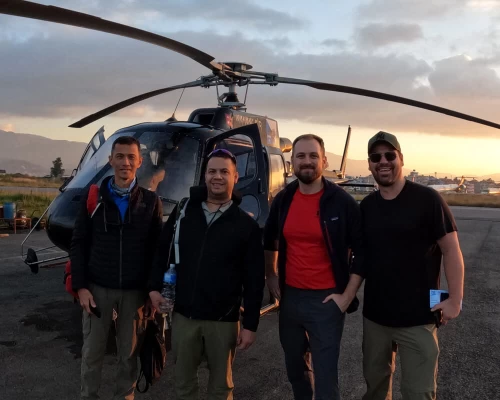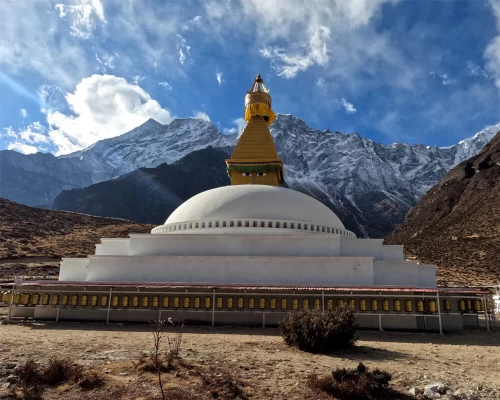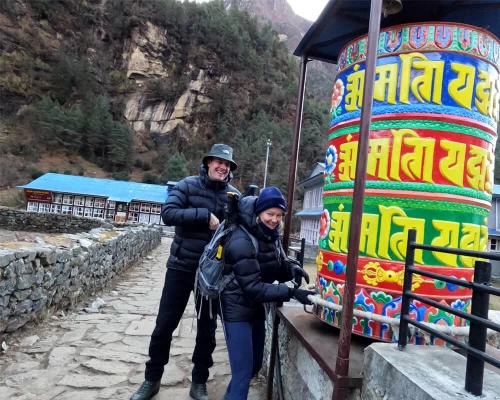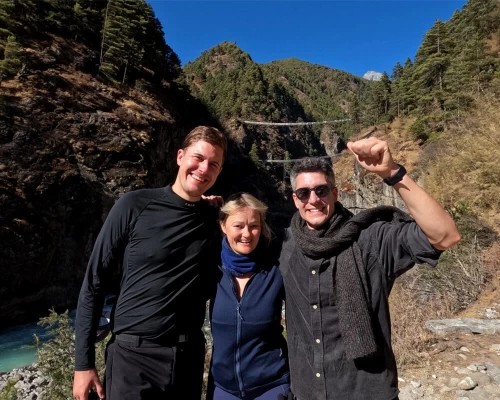"The three high passes trek is an unparalleled adventure in the Everest region of Nepal. This trek offers the ultimate Everest experience for those seeking an adventurous and daring journey. The trekking route encompasses breathtaking mountain vistas and the rich Sherpa culture. Note that the 3 passes trek is renowned for its formidable nature, ranking among the most demanding lodge treks in Nepal."
Embark on a thrilling adventure and immerse yourself in the ultimate Himalayan experience. This 19-day trek is an extension of the classic Everest Base Camp trek, leading you on a remarkable journey across three high mountain passes soaring above 5,000 meters: Kongma La pass (5,540 m/18,176 ft), Cho La pass (5,420 m/17,782 ft), and Renjo La pass (5,360 m/17,585 ft).
The three high passes trek presents a harmonious blend of breathtaking Himalayan landscapes and vibrant Sherpa cultural heritage. As you traverse, you will encounter remote villages nestled amidst towering peaks, high river valleys, and lush rhododendron forests. Throughout the trek, you will have the opportunity to experience lodge accommodations and understand the lifestyle of Sherpas.
The trek further takes you to three of the world's highest viewpoints: Kala Patthar (5,545 m/18,192 ft), Gokyo Ri (5,357 m/17,575 ft), and Chhukung Ri (5,546 m/18,196 ft). From the top of these majestic viewpoints, you will be treated to panoramic vistas that unveil the splendor of some of the world's highest mountains. The sight of Everest (8,849 m/29,032 ft), Lhotse (8,516 m/27,940 ft), Cho Oyu (8,188 m/26,864 ft), Nuptse (7,861 m/25,791 ft), Ama Dablam (6,812 m/22,349 ft), Makalu (8,481 m/27,825 ft), and many others are out of this world.
You will reach the Everest base camp (5,364 m/17,598 ft), the lap of the highest mountain in the world, Mount Everest. Similarly, our Everest three passes trek itinerary also takes you to the holy Gokyo Lakes (4,700–5,000 m) and lets you witness the grand view of Ngozumpa Glacier, the largest glacier in Nepal. The forests, mountains, locals, suspension bridges, flora and fauna, narrow streams, alpine lakes, and moraines, every aspect of this trek offers a lifetime experience.
How's is Kathmandu-Lulkla flight?
Lukla, located at an altitude of 2,860 meters (9,383 feet), serves as the gateway to the three high passes trekking route. As there are no roads connecting Kathmandu to Lukla, flying is the primary means of reaching Lukla and commencing the trek.
The flight from Kathmandu to Lukla is a thrilling experience. However, note that the flight can be subject to weather conditions, particularly during the monsoon and winter seasons, when fog and poor visibility may disrupt the schedule. Therefore, keep a few extra days to accommodate any potential flight delays or cancellations. In the spring and autumn seasons, the flights are mostly on time.
Is it possible to do a three-high pass trek without a guide?
Three passes trek in Nepal is considered strenuous and demanding, and having a knowledgeable guide can greatly enhance safety and navigation throughout the journey. We strongly do not recommend this specific trek without a guide because the risks are very high if you are trekking alone.
Still, if you choose to trek without a guide, it is essential to be well-prepared and equipped with proper maps, navigation tools, and trekking permits. Familiarize yourself with the route, including the locations of the high passes, rest stops, and possible acclimatization points. It is advisable to have prior experience with high-altitude trekking and be confident in your physical fitness and endurance.
What is the total distance during the Three Pass trek?
The total distance covered during the three high passes trek can vary depending on the specific route you take and the side trips chosen along the way. On average, the trek covers a distance of approximately 160–180 kilometers (100–112 miles) in total. This distance is usually completed over a span of 16–20 days, including acclimatization and rest days. The daily trekking distances can range from 10–20 kilometers (6–12 miles), with varying levels of elevation gain and loss.
Everest three high passes trek difficulty & altitude sickness
Terrain: The Everest three passes trail presents challenging and varied terrain. The trekking route is uneven and rugged in nature, requiring trekkers to navigate through different types of landscapes. The journey begins with traversing lush forests and meandering along foothills. As the trail ascends further, you will enter the alpine zone, where the scenery transforms into a more barren and rocky environment. The upper part of the trail includes sections with glaciers and moraine. Throughout the trek, you will encounter numerous ascents and descents, some of which are quite steep and demanding.
Elevation and altitude: During the three high passes trekking, each day the elevation gradually increases. This means that there is a definite risk of altitude sickness during the journey. Over the course of the entire trek, you will gain an impressive 5,545 meters, or 18,192 feet, in altitude. To mitigate the effects of altitude sickness, keep yourself well-hydrated and allow your body to acclimate to the changing conditions. Our experienced guide will consistently remind you to drink water and stay hydrated throughout the trek. If you experience any discomfort or symptoms related to altitude sickness, please don't hesitate to communicate with our guide, as they are trained to assist you in such situations.
How do I prepare for three-high pass trek Nepal?
The three high passes trek is a challenging and strenuous trek that requires good physical fitness. Engage in regular exercise and cardio workouts, such as hiking, running, or cycling, to build stamina and endurance. Likewise, invest in high-quality trekking gear, including sturdy hiking boots, comfortable clothing layers, a waterproof jacket, a warm sleeping bag, a backpack, trekking poles, and a good-quality backpack.
What are other alternative adventurous treks in Nepal?
As three high passes trek, we also have other similar-level treks in Nepal, such as the Manaslu circuit trek, Langtang Gosaikunda Helambu trek, Annapurna Circuit with Tilicho Lake trek, and the Kanchenjunga circuit trek. You can join any of these treks with us or customize your dream trek in Nepal.
What are the benefits of Everest three high passes trek with Nature Excursion?
We, Nature Excursion Team, are committed to providing our guests with an exceptional trekking experience on the three high passes trek 2024/2025 departures. Below are some of the benefits of choosing us as your trekking partner:
- Experienced and knowledgeable guides
- Customizable itinerary
- Safety and emergency support
- Small group size
- Responsible tourism
- Complimentary welcome or farewell dinners
- Free airport pick-up and drop-off service










-(1).webp)

.webp)
.webp)